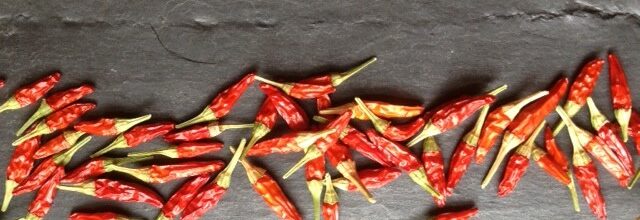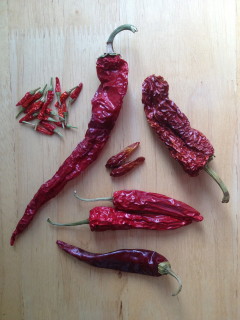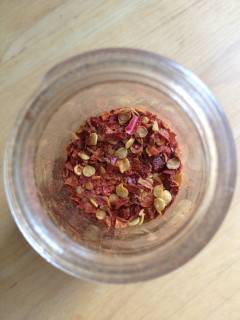Warning: Trying to access array offset on value of type null in /home/devonkarn/rootsnveggies.com/wp-content/themes/herothemetrust/functions.php on line 819
Add a little heat

Red chili flakes are one of those spices that I tend to reach for more than I realize. A few shakes go into soups, pasta sauces, egg bakes, chutneys, pizza – you get the idea. This year I tried making my own batch of chili flakes using dried red peppers from my garden and my mom’s. While I’m not sure it was worth the effort, there are some plusses and I’ll probably do it again anyway.

A variety of dried red chili peppers. What kind? I have no idea. I’m sometimes bad at keeping labels.
Every year I grow and dry tiny hot chili peppers whole (the smallest ones shown in the photo) to add heat to my pickles, particularly the dilly beans and pearl cocktail onions. I just snip them off the plant, lay them in single layers in the dehydrator, and flip it on. Once I’m sure they’re entirely dry (hard, shriveled, no sign of moisture left), I put them in an airtight jar on the shelf where I’ve found them to be still plenty hot two years later.
For the bigger peppers, I either string up and hang to air-dry in a warm spot with good circulation, or put in the dehydrator. Benefit to air-drying: you can plant the seeds for next year’s pepper crop (since they’re not cooked by the heat of the dehydrator). Drawback: if your house is humid, like ours is, the outsides can dry while the insides mold. The peppers will form dark spots and you’ll notice the mold fuzzes when you go to crack them open. If that happens, toss ’em.
To turn the dried peppers into chili powder, just snap off the stem ends, shake the seeds into a bowl, and crumble the dried chili walls into a small food processor. Pulse the chills until they become small flakes. (Note: I made the mistake of inhaling a little too close to the food processor after I opened the lid to check on their progress, which sent chili dust up my nose and down my throat, causing an alarming coughing fit. I don’t recommend doing that.) Once the red parts are flaked, mix the seeds back in and pour them into an air-tight jar. I like the ones that have a shaker top, which makes the flakes easier to use.

Jar of homemade chili flakes.
Because you get to select the pepper varieties to grow and/or dry, you can vary the flavor of the chili flakes based on your tastes. You could go ass-kicking hot, a little on the sweeter side, or just leave it up to whatever comes out of the garden. (It’s worth noting that even if you grow the same peppers every year, the heat can vary significantly from one season to the next based on how hot the summer temperatures get or how much rain falls. But hey, that’s part of the fun.) I suppose you could also smoke the chills, which I’m too lazy to do, and make chipotle flakes, too. Added bonus: I always end up with too many hot peppers in the garden to use fresh, so this is a nice way to avoid wasting such pretty red beauties.
You know what? I’ve just convinced myself it is worth the effort. As long as I can avoid assaulting myself with fiery pepper dust next year 🙂
